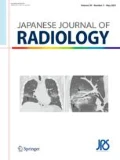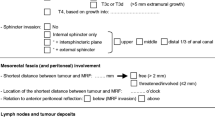Abstract
Purpose
To determine the relationship between the maximum slope (MS) of ultrafast dynamic contrast-enhanced (DCE)-MRI and prognostic factors of breast cancer.
Methods
One hundred thirteen patients with 118 breast cancers were included in this study. The ultrafast DCE sequence was acquired using a higher parallel imaging factor. Its spatial resolution was 0.9 × 0.9 × 2.5 mm and its temporal resolution was 8.3 s/phase. Each lesion was automatically segmented, and the ROI of highest enhancement in the lesion was identified. In this ROI, the MS was calculated. The MS of each lesion was compared with various prognostic factors of breast cancer.
Results
The MS of invasive cancer (median: 9.81%/sec) was significantly higher than that of ductal carcinoma in situ (median: 7.26%/sec) (p = 0.001). In the ROC analysis, the area under the ROC curve (AUC) was 0.7295. The MS of invasive cancer with axillary lymph node (LN) metastasis (median: 11.97%/sec) was significantly higher than that without axillary LN metastasis (median: 9.425%/sec) (p = 0.0024). In the ROC analysis, the AUC was 0.7177. In addition, the MS became significantly higher as the level of the proliferation marker ki-67 increased (correlation coefficient: 0.3317) (p = 0.0009).
Conclusions
MS of ultrafast DCE-MRI is useful for predicting the prognostic factors of breast cancer.
Secondary abstract
Higher maximum slope (MS) is significantly associated with an invasive breast cancer component. Higher MS is significantly associated with an axillary lymph node metastasis. MS becomes significantly higher with increasing ki-67 (a proliferation marker). Ultrafast MRI is useful for predicting the prognostic factors of breast cancer.





Similar content being viewed by others
References
Fischer U, Kopka L, Grabbe E. Breast carcinoma: effect of preoperative contrast-enhanced MR imaging on the therapeutic approach. Radiology. 1999;213(3):881–8.
Orel SG, Schnall MD. MR imaging of the breast for the detection, diagnosis, and staging of breast cancer. Radiology. 2001;220(1):13–30.
Van Goethem M, Schelfout K, Kersschot E, Colpaert C, Verslegers I, Biltjes I, et al. MR mammography is useful in the preoperative locoregional staging of breast carcinomas with extensive intraductal component. Eur J Radiol. 2007;62(2):273–82.
Lehman CD, Gatsonis C, Kuhl CK, Hendrick RE, Pisano ED, Hanna L, et al. MRI evaluation of the contralateral breast in women with recently diagnosed breast cancer. N Engl J Med. 2007;356(13):1295–303.
Yamaguchi K, Schacht D, Sennett CA, Newstead GM, Imaizumi T, Irie H, et al. Decision making for breast lesions initially detected at contrast-enhanced breast MRI. AJR Am J Roentgenol. 2013;201(6):1376–85.
Mann RM, Cho N, Moy L. Breast MRI: State of the Art. Radiology. 2019;292(3):520–36.
American College of Radiology. Breast imaging reporting and data system: ACR BI-RADS breast imaging atlas. 5th ed. 2013.
Mann RM, Mus RD, van Zelst J, Geppert C, Karssemeijer N, Platel B. A novel approach to contrast-enhanced breast magnetic resonance imaging for screening: high-resolution ultrafast dynamic imaging. Invest Radiol. 2014;49(9):579–85.
Abe H, Mori N, Tsuchiya K, Schacht DV, Pineda FD, Jiang Y, et al. Kinetic analysis of benign and malignant breast lesions with ultrafast dynamic contrast-enhanced mri: comparison with standard kinetic assessment. AJR Am J Roentgenol. 2016;207(5):1159–66.
Mus RD, Borelli C, Bult P, Weiland E, Karssemeijer N, Barentsz JO, et al. Time to enhancement derived from ultrafast breast MRI as a novel parameter to discriminate benign from malignant breast lesions. Eur J Radiol. 2017;89:90–6.
Vreemann S, Rodriguez-Ruiz A, Nickel D, Heacock L, Appelman L, van Zelst J, et al. Compressed sensing for breast MRI: resolving the trade-off between spatial and temporal resolution. Invest Radiol. 2017;52(10):574–82.
Mori N, Pineda FD, Tsuchiya K, Mugikura S, Takahashi S, Karczmar GS, et al. Fast temporal resolution dynamic contrast-enhanced MRI: histogram analysis versus visual analysis for differentiating benign and malignant breast lesions. AJR Am J Roentgenol. 2018;211(4):933–9.
Onishi N, Kataoka M, Kanao S, Sagawa H, Iima M, Nickel MD, et al. Ultrafast dynamic contrast-enhanced mri of the breast using compressed sensing: breast cancer diagnosis based on separate visualization of breast arteries and veins. JMRI. 2018;47(1):97–104.
Goto M, Sakai K, Yokota H, Kiba M, Yoshida M, Imai H, et al. Diagnostic performance of initial enhancement analysis using ultra-fast dynamic contrast-enhanced MRI for breast lesions. Eur Radiol. 2019;29(3):1164–74.
Honda M, Kataoka M, Onishi N, Iima M, Ohashi A, Kanao S, et al. New parameters of ultrafast dynamic contrast-enhanced breast MRI using compressed sensing. J Magn Reson Imaging. 2020;51:164–74.
Ohashi A, Kataoka M, Kanao S, Iima M, Murata K, Weiland E, et al. Diagnostic performance of maximum slope: A kinetic parameter obtained from ultrafast dynamic contrast-enhanced magnetic resonance imaging of the breast using k-space weighted image contrast (KWIC). Eur J Radiol. 2019;118:285–92.
Sagawa H, Kataoka M, Kanao S, Onishi N, Nickel MD, Toi M, et al. Impact of the number of iterations in compressed sensing reconstruction on ultrafast dynamic contrast-enhanced breast MR imaging. Magn Reson Med Sci. 2019;18:200–7.
Curigliano G, Burstein HJ, Winer EP, Gnant M, Dubsky P, Loibl S, et al (2017) De-escalating and escalating treatments for early-stage breast cancer: the St. Gallen International Expert Consensus Conference on the Primary Therapy of Early Breast Cancer. Ann Oncol 28(8):1700–12.
Chang YW, Kwon KH, Choi DL, Lee DW, Lee MH, Lee HK, et al (2009) Magnetic resonance imaging of breast cancer and correlation with prognostic factors. Acta Radiologica (Stockholm, Sweden: 1987)50(9):990–8.
Fernandez-Guinea O, Andicoechea A, Gonzalez LO, Gonzalez-Reyes S, Merino AM, Hernandez LC, et al. Relationship between morphological features and kinetic patterns of enhancement of the dynamic breast magnetic resonance imaging and clinico-pathological and biological factors in invasive breast cancer. BMC Cancer. 2010;10:8.
Kim JY, Kim SH, Kim YJ, Kang BJ, An YY, Lee AW, et al. Enhancement parameters on dynamic contrast enhanced breast MRI: do they correlate with prognostic factors and subtypes of breast cancers? Magn Reson Imaging. 2015;33(1):72–80.
Lee HS, Kim SH, Kang BJ, Baek JE, Song BJ. Perfusion parameters in dynamic contrast-enhanced MRI and apparent diffusion coefficient value in diffusion-weighted MRI: association with prognostic factors in breast cancer. Acad Radiol. 2016;23(4):446–56.
Wang C, Wei W, Santiago L, Whitman G, Dogan B (2018) Can imaging kinetic parameters of dynamic contrast-enhanced magnetic resonance imaging be valuable in predicting clinicopathological prognostic factors of invasive breast cancer? Acta Radiologica (Stockholm, Sweden: 1987) 59(7):813–21
Nagasaka K, Satake H, Ishigaki S, Kawai H, Naganawa S. Histogram analysis of quantitative pharmacokinetic parameters on DCE-MRI: correlations with prognostic factors and molecular subtypes in breast cancer. Breast Cancer (Tokyo, Japan). 2019;26(1):113–24.
Brown LF, Berse B, Jackman RW, Tognazzi K, Guidi AJ, Dvorak HF, et al. Expression of vascular permeability factor (vascular endothelial growth factor) and its receptors in breast cancer. Hum Pathol. 1995;26(1):86–91.
Fisher B, Bauer M, Wickerham DL, Redmond CK, Fisher ER, Cruz AB, et al. Relation of number of positive axillary nodes to the prognosis of patients with primary breast cancer An NSABP update. Cancer. 1983;52(9):1551–7.
Banerjee M, George J, Song EY, Roy A, Hryniuk W. Tree-based model for breast cancer prognostication. J Clin Oncol. 2004;22(13):2567–75.
Cianfrocca M, Goldstein LJ. Prognostic and predictive factors in early-stage breast cancer. Oncologist. 2004;9(6):606–16.
Horak ER, Leek R, Klenk N, LeJeune S, Smith K, Stuart N, et al. Angiogenesis, assessed by platelet/endothelial cell adhesion molecule antibodies, as indicator of node metastases and survival in breast cancer. Lancet (London, England). 1992;340(8828):1120–4.
Valkovic T, Dobrila F, Melato M, Sasso F, Rizzardi C, Jonjic N. Correlation between vascular endothelial growth factor, angiogenesis, and tumor-associated macrophages in invasive ductal breast carcinoma. Virchows Arch. 2002;440(6):583–8.
Sener E, Sipal S, Gundogdu C. Comparison of microvessel density with prognostic factors in invasive ductal carcinomas of the breast. Turk Patoloji Dergisi. 2016;32(3):164–70.
Funding
This research did not receive any specific grant from funding agencies in the public, commercial, or not-for-profit sectors.
Author information
Authors and Affiliations
Contributions
Ken Yamaguchi: conceptualization, methodology, software, formal analysis, writing – original draft. Takahiko Nakazono: investigation, writing – review and editing. Ryoko Egashira: investigation. Shuichi Fukui: software, validation, data curation. Koichi Baba: resources. Takahiro Hamamoto: resources. Hiroyuki Irie: supervision.
Corresponding author
Ethics declarations
Conflict of interest
All authors of this manuscript declare no relationships with any companies whose products or services may be related to the subject matter of the article.
Additional information
Publisher's Note
Springer Nature remains neutral with regard to jurisdictional claims in published maps and institutional affiliations.
About this article
Cite this article
Yamaguchi, K., Nakazono, T., Egashira, R. et al. Maximum slope of ultrafast dynamic contrast-enhanced MRI of the breast: Comparisons with prognostic factors of breast cancer. Jpn J Radiol 39, 246–253 (2021). https://doi.org/10.1007/s11604-020-01049-6
Received:
Accepted:
Published:
Issue Date:
DOI: https://doi.org/10.1007/s11604-020-01049-6




